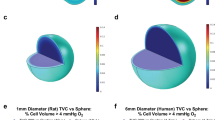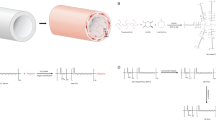Abstract
Small caliber synthetic vascular grafts are commonly used for bypass surgery and dialysis access sites but have high failure rates because of neointima formation and thrombosis. Seeding synthetic grafts with endothelial cells (ECs) provides a biocompatible surface that may prevent graft failure. However, EC detachment following exposure to blood flow still remains a major obstacle in the development of biosynthetic grafts. We tested the hypothesis that induced expression by the seeded EC, of vascular endothelial growth factor165 (VEGF165) and of fibulin-5, an extracellular matrix glycoprotein that has a crucial role in elastin fiber organization and increase EC adherence to surfaces, may improve long-term graft patency. Autologous ECs were isolated from venous segments, and were transduced with retroviral vectors expressing fibulin-5 and VEGF165. The modified cells were seeded on expanded polytetrafluoroethylene (ePTFE) grafts and implanted in a large animal model. Three months after transplantation, all grafts seeded with modified EC were patent on a selective angiography, whereas only a third of the control grafts were patent. Similar results were shown at 6 months. Thus, seeding ePTFE vascular grafts with genetically modified EC improved long-term small caliber graft patency. The biosynthetic grafts may provide a novel therapeutic modality for patients with peripheral vascular disease and patients requiring vascular access for hemodialysis.
This is a preview of subscription content, access via your institution
Access options
Subscribe to this journal
Receive 12 print issues and online access
$259.00 per year
only $21.58 per issue
Buy this article
- Purchase on Springer Link
- Instant access to full article PDF
Prices may be subject to local taxes which are calculated during checkout







Similar content being viewed by others

References
Voorhees AB Jr, Jaretzki A 3rd, Blakemore AH . The use of tubes constructed from vinyon "N" cloth in bridging arterial defects. Ann Surg 1952; 135: 332–336.
Devine C, McCollum C . Heparin-bonded Dacron or polytetrafluorethylene for femoropopliteal bypass: five-year results of a prospective randomized multicenter clinical trial. J Vasc Surg 2004; 40: 924–931.
Pereira CE, Albers M, Romiti M, Brochado-Neto FC, Pereira CA . Meta-analysis of femoropopliteal bypass grafts for lower extremity arterial insufficiency. J Vasc Surg 2006; 44: 510–517.
Greisler HP . Interactions at the blood/material interface. Ann Vasc Surg 1990; 4: 98–103.
Jensen N, Lindblad B, Ljungberg J, Leide S, Bergqvist D . Early attachment of platelets, leukocytes, and fibrinogen in endothelial cell seeded Dacron grafts. Ann Vasc Surg 1996; 10: 530–536.
Herring M, Gardner A, Glover J . A single-staged technique for seeding vascular grafts with autogenous endothelium. Surgery 1978; 84: 498–504.
Dardik A, Liu A, Ballermann BJ . Chronic in vitro shear stress stimulates endothelial cell retention on prosthetic vascular grafts and reduces subsequent in vivo neointimal thickness. J Vasc Surg 1999; 29: 157–167.
Vohra RK, Thomson GJ, Sharma H, Carr HM, Walker MG . Effects of shear stress on endothelial cell monolayers on expanded polytetrafluoroethylene (ePTFE) grafts using preclot and fibronectin matrices. Eur J Vasc Surg 1990; 4: 33–41.
Brown MA, Wallace CS, Anamelechi CC, Clermont E, Reichert WM, Truskey GA . The use of mild trypsinization conditions in the detachment of endothelial cells to promote subsequent endothelialization on synthetic surfaces. Biomaterials 2007; 28: 3928–3935.
Meinhart JG, Schense JC, Schima H, Gorlitzer M, Hubbell JA, Deutsch M et al. Enhanced endothelial cell retention on shear-stressed synthetic vascular grafts precoated with RGD-cross-linked fibrin. Tissue Eng 2005; 11: 887–895.
Dunn PF, Newman KD, Jones M, Yamada I, Shayani V, Virmani R et al. Seeding of vascular grafts with genetically modified endothelial cells. Secretion of recombinant TPA results in decreased seeded cell retention in vitro and in vivo. Circulation 1996; 93: 1439–1446.
Lahtinen M, Blomberg P, Baliulis G, Carlsson F, Khamis H, Zemgulis V . In vivo h-VEGF165 gene transfer improves early endothelialisation and patency in synthetic vascular grafts. Eur J Cardiothorac Surg 2007; 31: 383–390.
Turner NJ, Murphy MO, Kielty CM, Shuttleworth CA, Black RA, Humphries MJ et al. Alpha2(VIII) collagen substrata enhance endothelial cell retention under acute shear stress flow via an alpha2beta1 integrin-dependent mechanism: an in vitro and in vivo study. Circulation 2006; 114: 820–829.
Preis M, Cohen T, Sarnatzki Y, Ben Yosef Y, Schneiderman J, Gluzman Z et al. Effects of fibulin-5 on attachment, adhesion, and proliferation of primary human endothelial cells. Biochem Biophys Res Commun 2006; 348: 1024–1033.
Nakamura T, Ruiz-Lozano P, Lindner V, Yabe D, Taniwaki M, Furukawa Y et al. DANCE, a novel secreted RGD protein expressed in developing, atherosclerotic, and balloon-injured arteries. J Biol Chem 1999; 274: 22476–22483.
Kowal RC, Richardson JA, Miano JM, Olson EN . EVEC, a novel epidermal growth factor-like repeat-containing protein upregulated in embryonic and diseased adult vasculature. Circ Res 1999; 84: 1166–1176.
Nakamura T, Lozano PR, Ikeda Y, Iwanaga Y, Hinek A, Minamisawa S et al. Fibulin-5/DANCE is essential for elastogenesis in vivo. Nature 2002; 415: 171–175.
Yanagisawa H, Davis EC, Starcher BC, Ouchi T, Yanagisawa M, Richardson JA et al. Fibulin-5 is an elastin-binding protein essential for elastic fibre development in vivo. Nature 2002; 415: 168–171.
Albig AR, Schiemann WP . Fibulin-5 antagonizes vascular endothelial growth factor (VEGF) signaling and angiogenic sprouting by endothelial cells. DNA Cell Biol 2004; 23: 367–379.
Ferrara N, Davis-Smyth T . The biology of vascular endothelial growth factor. Endocr Rev 1997; 18: 4–25.
Neufeld G, Cohen T, Gengrinovitch S, Poltorak Z . Vascular endothelial growth factor (VEGF) and its receptors. Faseb J 1999; 13: 9–22.
Spencer JA, Hacker SL, Davis EC, Mecham RP, Knutsen RH, Li DY et al. Altered vascular remodeling in fibulin-5-deficient mice reveals a role of fibulin-5 in smooth muscle cell proliferation and migration. Proc Natl Acad Sci USA 2005; 102: 2946–2951.
Merklinger SL, Wagner RA, Spiekerkoetter E, Hinek A, Knutsen RH, Kabir MG et al. Increased fibulin-5 and elastin in S100A4/Mts1 mice with pulmonary hypertension. Circ Res 2005; 97: 596–604.
Minamino T, Kourembanas S . Mechanisms of telomerase induction during vascular smooth muscle cell proliferation. Circ Res 2001; 89: 237–243.
Koren B, Weisz A, Fischer L, Gluzman Z, Preis M, Avramovitch N et al. Efficient transduction and seeding of human endothelial cells onto metallic stents using bicistronic pseudo-typed retroviral vectors encoding vascular endothelial growth factor. Cardiovasc Revasc Med 2006; 7: 173–178.
Lomas AC, Mellody KT, Freeman LJ, Bax DV, Shuttleworth CA, Kielty CM . Fibulin-5 binds human smooth-muscle cells through alpha5beta1 and alpha4beta1 integrins, but does not support receptor activation. Biochem J 2007; 405: 417–428.
Schiemann WP, Blobe GC, Kalume DE, Pandey A, Lodish HF . Context-specific effects of fibulin-5 (DANCE/EVEC) on cell proliferation, motility, and invasion. Fibulin-5 is induced by transforming growth factor-beta and affects protein kinase cascades. J Biol Chem 2002; 277: 27367–27377.
Nguyen AD, Itoh S, Jeney V, Yanagisawa H, Fujimoto M, Ushio-Fukai M et al. Fibulin-5 is a novel binding protein for extracellular superoxide dismutase. Circ Res 2004; 95: 1067–1074.
Yanagisawa H, Schluterman MK, Brekken RA . Fibulin-5, an integrin-binding matricellular protein: its function in development and disease. J Cell Commun Signal 2009; 3: 337–347.
Korff T, Augustin HG . Integration of endothelial cells in multicellular spheroids prevents apoptosis and induces differentiation. J Cell Biol 1998; 143: 1341–1352.
Albig AR, Neil JR, Schiemann WP . Fibulins 3 and 5 antagonize tumor angiogenesis in vivo. Cancer Res 2006; 66: 2621–2629.
Ni H, Yuen PS, Papalia JM, Trevithick JE, Sakai T, Fassler R et al. Plasma fibronectin promotes thrombus growth and stability in injured arterioles. Proc Natl Acad Sci USA 2003; 100: 2415–2419.
Poole-Warren LA, Schindhelm K, Graham AR, Slowiaczek PR, Noble KR . Performance of small diameter synthetic vascular prostheses with confluent autologous endothelial cell linings. J Biomed Mater Res 1996; 30: 221–229.
Zhang Z, Wang Z, Liu S, Kodama M . Pore size, tissue ingrowth, and endothelialization of small-diameter microporous polyurethane vascular prostheses. Biomaterials 2004; 25: 177–187.
Sato M, Harasaki H . Evaluation of platelet and coagulation function in different animal species using the xylum clot signature analyzer. Asaio J 2002; 48: 360–364.
Ortenwall P, Bylock A, Kjellstrom BT, Risberg B . Seeding of ePTFE carotid interposition grafts in sheep and dogs: species-dependent results. Surgery 1988; 103: 199–205.
Chen J, Reeves L, Cornetta K . Safety testing for replication-competent retrovirus associated with gibbon ape leukemia virus-pseudotyped retroviral vectors. Hum Gene Ther 2001; 12: 61–70.
Hacein-Bey-Abina S, Von Kalle C, Schmidt M, McCormack MP, Wulffraat N, Leboulch P et al. LMO2-associated clonal T cell proliferation in two patients after gene therapy for SCID-X1. Science 2003; 302: 415–419.
Bunting KD, Galipeau J, Topham D, Benaim E, Sorrentino BP . Transduction of murine bone marrow cells with an MDR1 vector enables ex vivo stem cell expansion, but these expanded grafts cause a myeloproliferative syndrome in transplanted mice. Blood 1998; 92: 2269–2279.
Furie N, Shteynberg D, Elkhatib R, Perry L, Ullmann Y, Feferman Y et al. Fibulin-5 regulates keloid-derived fibroblast-like cells through integrin beta-1. Int J Cosmet Sci 2015, e-pub ahead of print 14 July 2015 doi:10.1111/ics.12245.
Flugelman MY, Virmani R, Leon MB, Bowman RL, Dichek DA . Genetically engineered endothelial cells remain adherent and viable after stent deployment and exposure to flow in vitro. Circ Res 1992; 70: 348–354.
Gluzman Z, Koren B, Preis M, Cohen T, Tsaba A, Cosset FL et al. Endothelial cells are activated by angiopoeitin-1 gene transfer and produce coordinated sprouting in vitro and arteriogenesis in vivo. Biochem Biophys Res Commun 2007; 359: 263–268.
Gingis-Velitski S, Zetser A, Flugelman MY, Vlodavsky I, Ilan N . Heparanase induces endothelial cell migration via protein kinase B/Akt activation. J Biol Chem 2004; 279: 23536–23541.
Towers GJ, Stockholm D, Labrousse-Najburg V, Carlier F, Danos O, Pages JC . One step screening of retroviral producer clones by real time quantitative PCR. J Gene Med 1999; 1: 352–359.
Aiuti A, Slavin S, Aker M, Ficara F, Deola S, Mortellaro A et al. Correction of ADA-SCID by stem cell gene therapy combined with nonmyeloablative conditioning. Science 2002; 296: 2410–2413.
Kustikova OS, Wahlers A, Kuhlcke K, Stahle B, Zander AR, Baum C et al. Dose finding with retroviral vectors: correlation of retroviral vector copy numbers in single cells with gene transfer efficiency in a cell population. Blood 2003; 102: 3934–3937.
Guzman RJ, Lemarchand P, Crystal RG, Epstein SE, Finkel T . Efficient and selective adenovirus-mediated gene transfer into vascular neointima. Circulation 1993; 88: 2838–2848.
Acknowledgements
This work was partially supported by a grant from the Israel Academy of Science.
Author information
Authors and Affiliations
Corresponding author
Ethics declarations
Competing interests
The following authors are or were employees of MGVS Ltd, Haifa, Israel: Belly Koren, Yaara Ben-Yosef, Dana Levin Ashkenazi, Tzafra Cohen, Mira Israeli-Amit, Yael Sarnatzki, Diana Gershtein. Basil S Lewis and Moshe Y Flugelman are the founders of MGVS Ltd. The following authors are or were supported or consultants to MGVS Ltd, Haifa, Israel: Meir Preis (until 2009), Jacob Schneiderman, Rona Shofti.
Additional information
This work was done in Haifa, Israel.
Supplementary Information accompanies this paper on Gene Therapy website
Supplementary information
Rights and permissions
About this article
Cite this article
Preis, M., Schneiderman, J., Koren, B. et al. Co-expression of fibulin-5 and VEGF165 increases long-term patency of synthetic vascular grafts seeded with autologous endothelial cells. Gene Ther 23, 237–246 (2016). https://doi.org/10.1038/gt.2015.104
Received:
Revised:
Accepted:
Published:
Issue Date:
DOI: https://doi.org/10.1038/gt.2015.104
This article is cited by
-
On the length, weight and GC content of the human genome
BMC Research Notes (2019)


